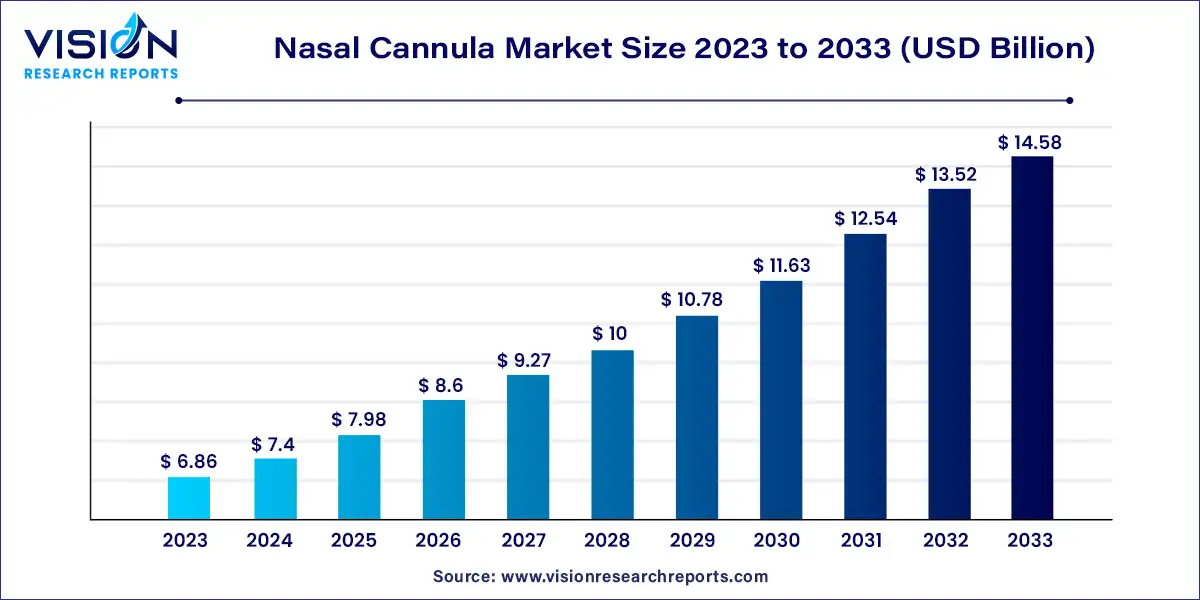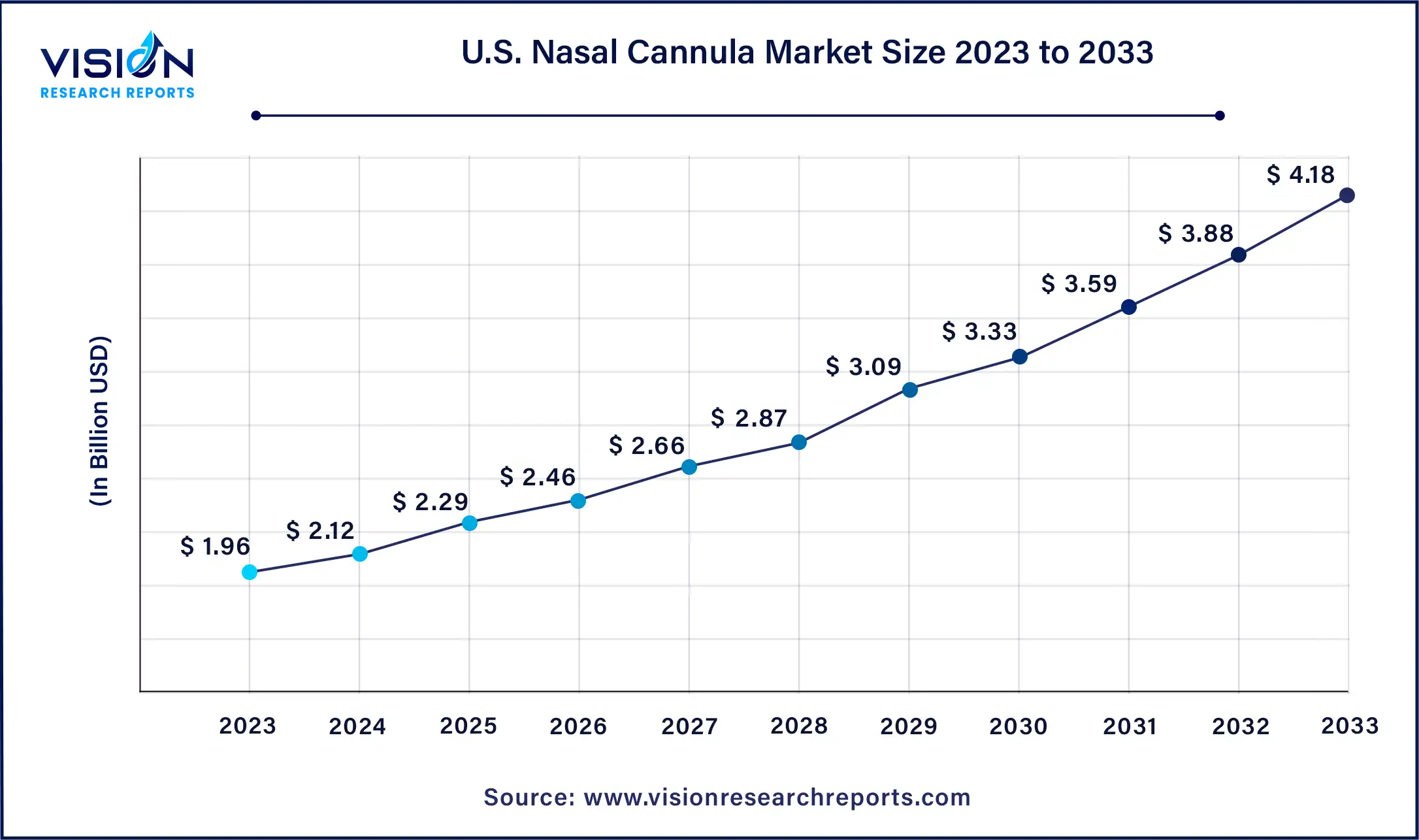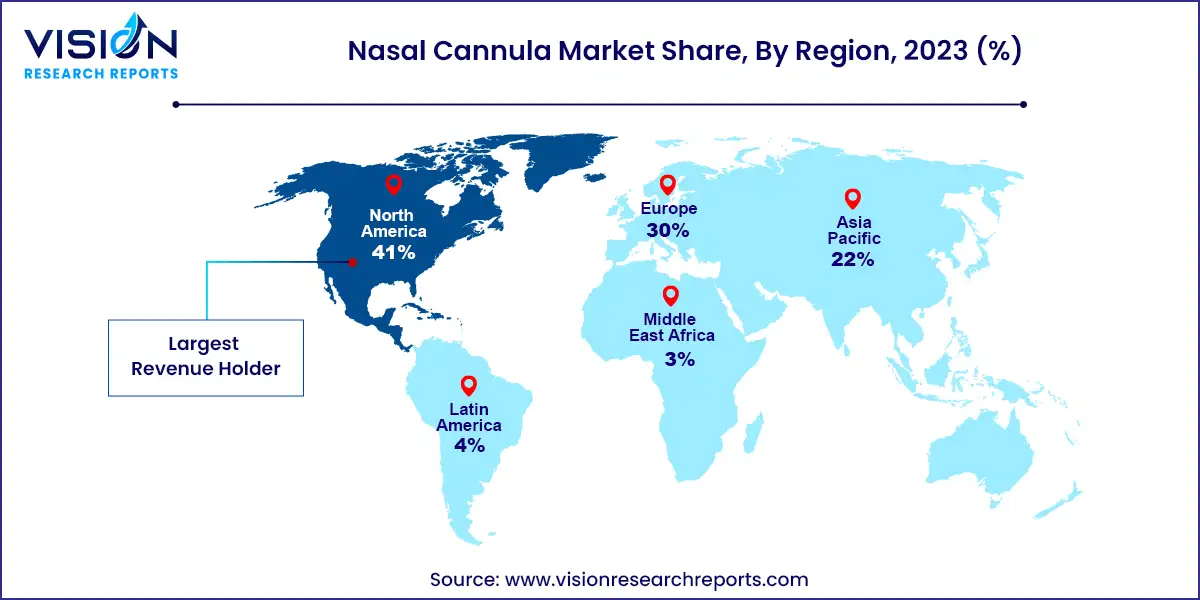The global nasal cannula market size was estimated at around USD 6.86 billion in 2023 and it is projected to hit around USD 14.58 billion by 2033, growing at a CAGR of 7.83% from 2024 to 2033.

The nasal cannula market is witnessing significant growth driven by increasing prevalence of respiratory diseases and the rising demand for home healthcare solutions. Nasal cannulas are widely utilized in medical settings to deliver supplemental oxygen to patients suffering from various respiratory conditions, such as chronic obstructive pulmonary disease (COPD), asthma, and respiratory distress syndrome.
The growth of the nasal cannula market is primarily fueled by the rising prevalence of respiratory diseases worldwide and the increasing adoption of home healthcare solutions. With a growing elderly population susceptible to respiratory ailments, there is a heightened demand for effective respiratory support devices like nasal cannulas. Moreover, advancements in healthcare infrastructure, including technological innovations and improved patient care facilities, are further driving market growth. The shift towards home-based treatment options is also significantly boosting the market, as nasal cannulas are increasingly used outside traditional hospital settings, contributing to their widespread adoption and market expansion.
The U.S. nasal cannula market size was estimated at around USD 1.96 billion in 2023 and is projected to hit around USD 4.18 billion by 2033, growing at a CAGR of 7.86% from 2024 to 2033.

North America dominated the market in 2023 with a 41% revenue share, driven by high healthcare expenditure on chronic respiratory diseases like COPD and asthma. The region benefits from a robust presence of local and international manufacturers, ensuring competitive pricing and availability of nasal cannula products.

Meanwhile, the Asia Pacific market is experiencing rapid growth, projected to achieve a CAGR of 9.83% by 2033. Factors contributing to this growth include a large population base, increasing healthcare investments, improving healthcare infrastructure, and rising awareness of respiratory health issues.
The low flow segment established dominance in the market, capturing a substantial 63% revenue share in 2023. Its widespread adoption in home care, ambulatory, and long-term care settings for stable patients requiring low to medium concentration oxygen has been a key driver. The affordability of low flow nasal cannulas has further propelled its market share growth.
Conversely, the high flow nasal cannula segment is poised for significant growth with an anticipated CAGR of 8.73% from 2024 to 2033. This growth is driven by increasing acceptance for critically ill patients and expanding applications in low-level healthcare facilities and home settings.
In 2023, plastic nasal cannulas dominated with an 86% revenue share, owing to their affordability, comfort, and widespread availability. However, silicone nasal cannulas are gaining popularity among patients requiring long-term oxygen therapy, particularly those sensitive to plastic materials or experiencing nasal and skin irritations.
Hospitals led the market with a 47% revenue share in 2023, driven by the rising utilization of high-flow nasal cannulas for severe respiratory conditions. The segment is expected to grow at a CAGR of 8.13% from 2024 to 2033, supported by an aging population and increasing prevalence of chronic respiratory diseases.
Long-term care centers are also poised for significant growth, driven by the expanding geriatric population and rising demand for respiratory care solutions.
By Type
By Material
By End-use
By Region
Chapter 1. Introduction
1.1. Research Objective
1.2. Scope of the Study
1.3. Definition
Chapter 2. Research Methodology
2.1. Research Approach
2.2. Data Sources
2.3. Assumptions & Limitations
Chapter 3. Executive Summary
3.1. Market Snapshot
Chapter 4. Market Variables and Scope
4.1. Introduction
4.2. Market Classification and Scope
4.3. Industry Value Chain Analysis
4.3.1. Raw Material Procurement Analysis
4.3.2. Sales and Distribution Type Analysis
4.3.3. Downstream Buyer Analysis
Chapter 5. COVID 19 Impact on Nasal Cannula Market
5.1. COVID-19 Landscape: Nasal Cannula Industry Impact
5.2. COVID 19 - Impact Assessment for the Industry
5.3. COVID 19 Impact: Global Major Government Policy
5.4. Market Trends and Opportunities in the COVID-19 Landscape
Chapter 6. Market Dynamics Analysis and Trends
6.1. Market Dynamics
6.1.1. Market Drivers
6.1.2. Market Restraints
6.1.3. Market Opportunities
6.2. Porter’s Five Forces Analysis
6.2.1. Bargaining power of suppliers
6.2.2. Bargaining power of buyers
6.2.3. Threat of substitute
6.2.4. Threat of new entrants
6.2.5. Degree of competition
Chapter 7. Competitive Landscape
7.1.1. Company Market Share/Positioning Analysis
7.1.2. Key Strategies Adopted by Players
7.1.3. Vendor Landscape
7.1.3.1. List of Suppliers
7.1.3.2. List of Buyers
Chapter 8. Global Nasal Cannula Market, By Type
8.1. Nasal Cannula Market, by Type, 2024-2033
8.1.1 Low Flow Nasal Cannula
8.1.1.1. Market Revenue and Forecast (2021-2033)
8.1.2. High Flow Nasal Cannula
8.1.2.1. Market Revenue and Forecast (2021-2033)
Chapter 9. Global Nasal Cannula Market, By Material
9.1. Nasal Cannula Market, by Material, 2024-2033
9.1.1. Plastic
9.1.1.1. Market Revenue and Forecast (2021-2033)
9.1.2. Silicone
9.1.2.1. Market Revenue and Forecast (2021-2033)
Chapter 10. Global Nasal Cannula Market, By End-use
10.1. Nasal Cannula Market, by End-use, 2024-2033
10.1.1. Hospitals
10.1.1.1. Market Revenue and Forecast (2021-2033)
10.1.2. Ambulatory Healthcare Services
10.1.2.1. Market Revenue and Forecast (2021-2033)
10.1.3. Long Term Care Centers
10.1.3.1. Market Revenue and Forecast (2021-2033)
10.1.4. Others
10.1.4.1. Market Revenue and Forecast (2021-2033)
Chapter 11. Global Nasal Cannula Market, Regional Estimates and Trend Forecast
11.1. North America
11.1.1. Market Revenue and Forecast, by Type (2021-2033)
11.1.2. Market Revenue and Forecast, by Material (2021-2033)
11.1.3. Market Revenue and Forecast, by End-use (2021-2033)
11.1.4. U.S.
11.1.4.1. Market Revenue and Forecast, by Type (2021-2033)
11.1.4.2. Market Revenue and Forecast, by Material (2021-2033)
11.1.4.3. Market Revenue and Forecast, by End-use (2021-2033)
11.1.5. Rest of North America
11.1.5.1. Market Revenue and Forecast, by Type (2021-2033)
11.1.5.2. Market Revenue and Forecast, by Material (2021-2033)
11.1.5.3. Market Revenue and Forecast, by End-use (2021-2033)
11.2. Europe
11.2.1. Market Revenue and Forecast, by Type (2021-2033)
11.2.2. Market Revenue and Forecast, by Material (2021-2033)
11.2.3. Market Revenue and Forecast, by End-use (2021-2033)
11.2.4. UK
11.2.4.1. Market Revenue and Forecast, by Type (2021-2033)
11.2.4.2. Market Revenue and Forecast, by Material (2021-2033)
11.2.4.3. Market Revenue and Forecast, by End-use (2021-2033)
11.2.5. Germany
11.2.5.1. Market Revenue and Forecast, by Type (2021-2033)
11.2.5.2. Market Revenue and Forecast, by Material (2021-2033)
11.2.5.3. Market Revenue and Forecast, by End-use (2021-2033)
11.2.6. France
11.2.6.1. Market Revenue and Forecast, by Type (2021-2033)
11.2.6.2. Market Revenue and Forecast, by Material (2021-2033)
11.2.6.3. Market Revenue and Forecast, by End-use (2021-2033)
11.2.7. Rest of Europe
11.2.7.1. Market Revenue and Forecast, by Type (2021-2033)
11.2.7.2. Market Revenue and Forecast, by Material (2021-2033)
11.2.7.3. Market Revenue and Forecast, by End-use (2021-2033)
11.3. APAC
11.3.1. Market Revenue and Forecast, by Type (2021-2033)
11.3.2. Market Revenue and Forecast, by Material (2021-2033)
11.3.3. Market Revenue and Forecast, by End-use (2021-2033)
11.3.4. India
11.3.4.1. Market Revenue and Forecast, by Type (2021-2033)
11.3.4.2. Market Revenue and Forecast, by Material (2021-2033)
11.3.4.3. Market Revenue and Forecast, by End-use (2021-2033)
11.3.5. China
11.3.5.1. Market Revenue and Forecast, by Type (2021-2033)
11.3.5.2. Market Revenue and Forecast, by Material (2021-2033)
11.3.5.3. Market Revenue and Forecast, by End-use (2021-2033)
11.3.6. Japan
11.3.6.1. Market Revenue and Forecast, by Type (2021-2033)
11.3.6.2. Market Revenue and Forecast, by Material (2021-2033)
11.3.6.3. Market Revenue and Forecast, by End-use (2021-2033)
11.3.7. Rest of APAC
11.3.7.1. Market Revenue and Forecast, by Type (2021-2033)
11.3.7.2. Market Revenue and Forecast, by Material (2021-2033)
11.3.7.3. Market Revenue and Forecast, by End-use (2021-2033)
11.4. MEA
11.4.1. Market Revenue and Forecast, by Type (2021-2033)
11.4.2. Market Revenue and Forecast, by Material (2021-2033)
11.4.3. Market Revenue and Forecast, by End-use (2021-2033)
11.4.4. GCC
11.4.4.1. Market Revenue and Forecast, by Type (2021-2033)
11.4.4.2. Market Revenue and Forecast, by Material (2021-2033)
11.4.4.3. Market Revenue and Forecast, by End-use (2021-2033)
11.4.5. North Africa
11.4.5.1. Market Revenue and Forecast, by Type (2021-2033)
11.4.5.2. Market Revenue and Forecast, by Material (2021-2033)
11.4.5.3. Market Revenue and Forecast, by End-use (2021-2033)
11.4.6. South Africa
11.4.6.1. Market Revenue and Forecast, by Type (2021-2033)
11.4.6.2. Market Revenue and Forecast, by Material (2021-2033)
11.4.6.3. Market Revenue and Forecast, by End-use (2021-2033)
11.4.7. Rest of MEA
11.4.7.1. Market Revenue and Forecast, by Type (2021-2033)
11.4.7.2. Market Revenue and Forecast, by Material (2021-2033)
11.4.7.3. Market Revenue and Forecast, by End-use (2021-2033)
11.5. Latin America
11.5.1. Market Revenue and Forecast, by Type (2021-2033)
11.5.2. Market Revenue and Forecast, by Material (2021-2033)
11.5.3. Market Revenue and Forecast, by End-use (2021-2033)
11.5.4. Brazil
11.5.4.1. Market Revenue and Forecast, by Type (2021-2033)
11.5.4.2. Market Revenue and Forecast, by Material (2021-2033)
11.5.4.3. Market Revenue and Forecast, by End-use (2021-2033)
11.5.5. Rest of LATAM
11.5.5.1. Market Revenue and Forecast, by Type (2021-2033)
11.5.5.2. Market Revenue and Forecast, by Material (2021-2033)
11.5.5.3. Market Revenue and Forecast, by End-use (2021-2033)
Chapter 12. Company Profiles
12.1. Allied Medical LLC.
12.1.1. Company Overview
12.1.2. Product Offerings
12.1.3. Financial Performance
12.1.4. Recent Initiatives
12.2. Teleflex Incorporated.
12.2.1. Company Overview
12.2.2. Product Offerings
12.2.3. Financial Performance
12.2.4. Recent Initiatives
12.3. Flexicare (Group) Limited.
12.3.1. Company Overview
12.3.2. Product Offerings
12.3.3. Financial Performance
12.3.4. Recent Initiatives
12.4. Vapotherm.
12.4.1. Company Overview
12.4.2. Product Offerings
12.4.3. Financial Performance
12.4.4. Recent Initiatives
12.5. ResMed.
12.5.1. Company Overview
12.5.2. Product Offerings
12.5.3. Financial Performance
12.5.4. Recent Initiatives
12.6. Fisher & Paykel Healthcare Limited.
12.6.1. Company Overview
12.6.2. Product Offerings
12.6.3. Financial Performance
12.6.4. Recent Initiatives
12.7. Well Lead Medical Co., Ltd.
12.7.1. Company Overview
12.7.2. Product Offerings
12.7.3. Financial Performance
12.7.4. Recent Initiatives
12.8. SunMED,LLC
12.8.1. Company Overview
12.8.2. Product Offerings
12.8.3. Financial Performance
12.8.4. Recent Initiatives
Chapter 13. Research Methodology
13.1. Primary Research
13.2. Secondary Research
13.3. Assumptions
Chapter 14. Appendix
14.1. About Us
14.2. Glossary of Terms
 Cross-segment Market Size and Analysis for
Mentioned Segments
Cross-segment Market Size and Analysis for
Mentioned Segments
 Additional Company Profiles (Upto 5 With No Cost)
Additional Company Profiles (Upto 5 With No Cost)
 Additional Countries (Apart From Mentioned Countries)
Additional Countries (Apart From Mentioned Countries)
 Country/Region-specific Report
Country/Region-specific Report
 Go To Market Strategy
Go To Market Strategy
 Region Specific Market Dynamics
Region Specific Market Dynamics Region Level Market Share
Region Level Market Share Import Export Analysis
Import Export Analysis Production Analysis
Production Analysis Others
Others